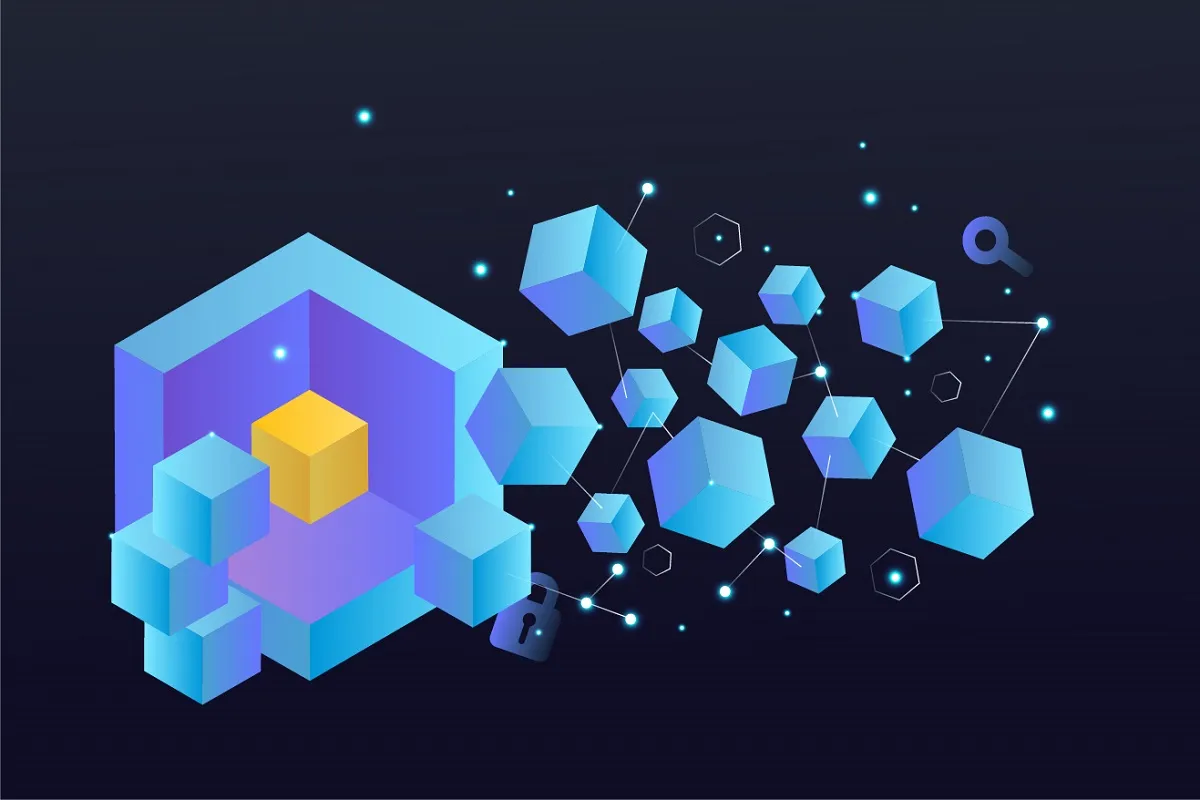Blockchain technology, a system that keeps records on a network of computers, has grown remarkably over the years. It started with Bitcoin, a popular cryptocurrency, but now it’s much more.
This technology is at the heart of Web3, the newest phase in our digital world. Web3 represents a significant shift towards a more decentralized online experience, where users have greater control and ownership over their data and digital assets.
In this evolution, blockchain plays a crucial role. It’s not just about cryptocurrencies like Bitcoin or Ethereum anymore; blockchain is now the foundation for many innovative Web3 developments. These include things like NFTs (Non-Fungible Tokens), which have transformed art and collectibles, and DeFi (Decentralized Finance), which is changing how we think about money and investments.
The influence of blockchain in shaping Web3 cannot be overstated. It has opened the door to a realm where digital interactions are more secure, transparent, and user-centric.
As we dive deeper into this blog, we’ll explore how blockchain technology is not only a part of Web3 but a driving force behind many cutting-edge trends and technologies in this exciting new digital era.
The Foundation of Web3: Understanding Blockchain’s Role
Blockchain technology is often seen as the backbone of Web3, the next big step in our online world. This technology, known for its key features of decentralization, security, and transparency, is what makes Web3 different from the previous internet versions.
In simple terms, blockchain allows information to be stored and shared across a network of computers, making it very secure and hard to tamper with. This is because, unlike traditional systems, there’s no single point of control or failure.
Decentralization, a core aspect of blockchain, means that the power and control are spread across many people or entities, rather than being held by just one. This feature is crucial in Web3, where the focus is on giving users more control over their data and online interactions.
Web3 Architecture Explained: A Paradigm Shift from Traditional Apps
Security in blockchain comes from its ability to keep data safe and unchangeable, which is essential in an online world where data breaches are common. Transparency is another key feature, as blockchain provides a clear and open record of all transactions or data exchanges, making everything more trustworthy.
These features of blockchain are what enable the unique functionalities of Web3. For instance, smart contracts, which are self-executing contracts with the terms directly written into code, operate on blockchain technology. They automate processes and transactions, ensuring they happen smoothly and without the need for middlemen. This not only saves time but also reduces the potential for errors or fraud.
Similarly, Decentralized Finance (DeFi), a system where financial products become available on a public decentralized blockchain network, is made possible by blockchain. This means that traditional finance services like borrowing, lending, and trading can be done over the blockchain, providing more accessibility and reducing dependency on institutions like banks.
Current Trends in Blockchain and Web3
The Evolution of Blockchain and Web3
Blockchain technology and Web3 have been evolving rapidly, with new trends constantly emerging. These trends are reshaping how we interact with the digital world, offering more innovative and user-centric solutions.
The blockchain/Web3 space is buzzing with developments that are not just exciting but also hold great potential for the future.
Deep Dive into Key Web3 Trends
Among the most talked-about trends in the Web3 space are Decentralized Finance (DeFi), Non-Fungible Tokens (NFTs), Decentralized Autonomous Organizations (DAOs), interoperability, and layer 2 solutions.
- DeFi is changing the face of finance, allowing for financial transactions and services to be conducted without traditional banks.
- NFTs have revolutionized the art and collectibles market, enabling digital ownership in a way that was not possible before.
- DAOs represent a new form of organizational structure, run by code and community rather than centralized leadership.
- Interoperability refers to the increasing ability of different blockchain networks to work together and share information.
- Layer 2 solutions are innovations that help scale blockchain applications by handling transactions off the main blockchain, speeding up processes and reducing costs.
Innovative Case Studies in the Blockchain World
There are numerous examples of innovative blockchain projects making waves in the Web3 space. For instance, there are platforms that are transforming art and gaming through NFTs, enabling artists and gamers to have true ownership of their digital assets.
In finance, DeFi platforms are providing users with alternatives to traditional banking, offering services like lending, borrowing, and earning interest on cryptocurrency holdings.
Additionally, DAOs are emerging as a new way to manage and govern organizations, bringing more democracy and transparency to decision-making processes.
Each of these trends and examples highlights the dynamic and transformative nature of blockchain and Web3. They not only represent the current state of this evolving space but also give us a glimpse into the future of how we will interact with the digital world.
Emerging Technologies within Blockchain
Advancements in Blockchain Technology
In the world of blockchain, new technologies are constantly emerging, significantly enhancing the capabilities of Web3. These advancements are crucial for improving various aspects of blockchain, such as its ability to handle more transactions, secure user privacy, and operate more efficiently.
Sharding and Zero-Knowledge Proofs: Enhancing Blockchain
Two notable technologies in this evolution are sharding and zero-knowledge proofs. Sharding is a process that breaks down the blockchain into smaller, more manageable pieces, or ‘shards’.
This method is especially useful for handling more transactions at once, which improves the blockchain’s scalability – its ability to grow and manage increased demand. In simpler terms, sharding makes blockchain like a highway with more lanes, allowing more traffic to flow smoothly without congestion.
Zero-knowledge proofs, on the other hand, are a way of sharing information without revealing the information itself. This technology enhances privacy by allowing users to verify transactions or data without exposing any underlying details. It’s akin to proving you know a secret without actually disclosing the secret itself.
The Impact of These Technologies on Web3
These technologies have a significant impact on the efficiency and functionality of Web3. By solving issues related to scalability and privacy, they make blockchain more practical and usable for a wide range of applications.
From faster transaction times to more secure and private interactions, these advancements are paving the way for a more robust and user-friendly Web3 experience.
In summary, the integration of technologies like sharding and zero-knowledge proofs is a major step forward in the blockchain and Web3 domains. They not only address some of the key challenges faced by blockchain technology but also open up new possibilities for its application in our digital world.
Challenges and Solutions in Blockchain Technology
Addressing Blockchain Challenges
While blockchain technology has brought remarkable changes to our digital world, it also faces some challenges. Two major issues are scalability and energy consumption. Scalability refers to the ability of the blockchain to handle a large number of transactions.
As more people use blockchain, the demand for faster and more efficient processing increases. Energy consumption is another concern, especially with networks like Bitcoin, which require significant amounts of energy for transaction verification and mining processes.
Innovative Solutions for a Better Blockchain
Researchers and developers are actively working on solutions to these challenges. One such solution for the scalability issue is ‘proof of stake’. This is a method used to validate transactions that is considered more energy-efficient than the traditional ‘proof of work’ system used by networks like Bitcoin.
In proof of stake, the validators of transactions are chosen based on the number of coins they hold, which requires less computational power and, consequently, less energy.
Another approach to tackle these issues is off-chain computations.
This involves handling certain processes outside the main blockchain. By doing some work off the main network, the strain on the blockchain is reduced, leading to faster and more efficient operations. Think of it as delegating tasks to reduce the workload on a busy team.
The Future of Blockchain: Continuous Improvement
The ongoing research and development in these areas show the commitment of the blockchain community to overcome these challenges. By finding innovative solutions like proof of stake and off-chain computations, the blockchain is evolving to be more efficient and sustainable.
As these solutions are implemented, we can expect blockchain technology to become more adaptable and powerful, making it even more integral to the future of our digital interactions.
The Future of Blockchain in Web3
Predicting the Blockchain Revolution in Web3
As we look ahead, the future of blockchain technology within Web3 seems bright and full of potential. Experts predict that this technology will continue to evolve, bringing even more innovative changes to how we interact online.
Blockchain is expected to become a key player in shaping a new, decentralized version of the internet – a place where users have more control and ownership over their data and digital activities.
Blockchain’s Impact Across Industries
The impact of blockchain is not limited to just one area; it’s set to revolutionize a variety of industries. In finance, blockchain could make transactions faster, more secure, and accessible to people without traditional banking.
The art world is already seeing changes with the rise of NFTs, allowing digital artists to sell their work in a whole new way. In gaming, blockchain introduces unique opportunities for players to own and trade in-game assets.
The supply chain industry could also benefit from the enhanced transparency and traceability that blockchain provides, ensuring the authenticity of products and streamlining processes.
Shaping a Decentralized Internet with Blockchain
One of the most significant roles of blockchain in the Web3 era is its contribution to creating a decentralized internet. This means moving away from the current model, where a few large companies control much of the online world, to a more distributed and user-empowered model.
Beyond Silicon Valley: Can Tech Solve the World’s Biggest Problems?
Blockchain technology, with its decentralized nature, is perfectly suited to support this shift. It promises a future where users have greater control over their digital identities and online experiences, leading to a more open, transparent, and fair internet.
Bottom Line: Embracing the Blockchain-Powered Future
As we conclude our exploration of blockchain in the Web3 era, it’s clear that this technology is more than just a digital trend; it’s a fundamental shift in how we interact with the online world. Blockchain has been recognized not only for its role in cryptocurrencies but also for its broader impact across various industries and its potential to reshape the internet as we know it.
The journey of blockchain, from its early days to its current state, shows a technology that is constantly evolving, overcoming challenges, and unlocking new possibilities. Its ability to provide security, transparency, and decentralization is what makes it so revolutionary.
As blockchain continues to grow and integrate into different sectors, from finance to art and beyond, its influence on our digital lives becomes increasingly significant.
Looking ahead, the integration of blockchain in Web3 promises a future where digital interactions are more user-centric, secure, and equitable.
This technology is paving the way for a decentralized internet, where users have greater control and ownership over their data and digital assets. The ongoing advancements and innovations in blockchain technology are not just exciting; they are laying the groundwork for a more connected and empowered digital world.



